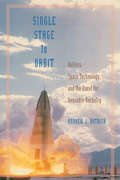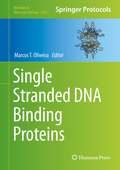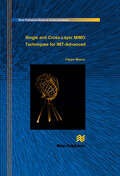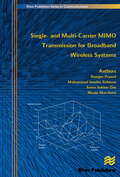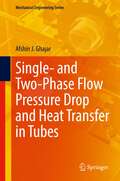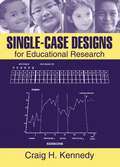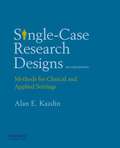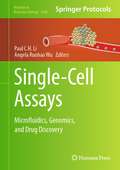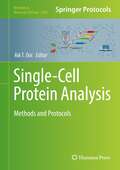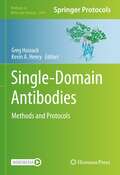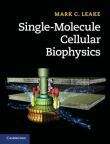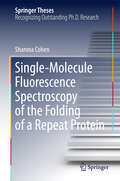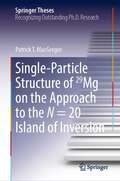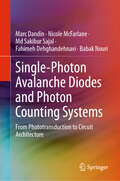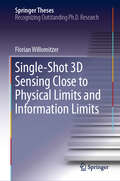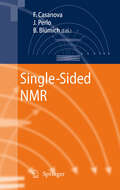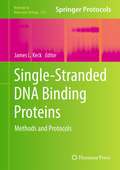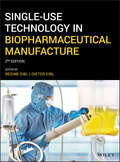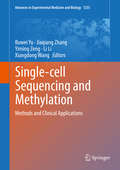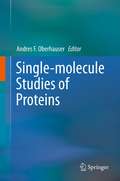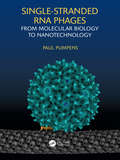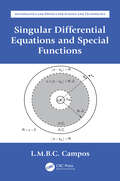- Table View
- List View
Single Particle Detection And Measurement
by R S GilmoreThis book provides a summary of the state of science in teh field of single particle detection and measurement. The text delineates between those low performance detectors, capable of registering only a large number of particles and those complex, highly designed systems capable of detecting and measuring single interactions or events. The author describes the problems associated with detection, measurement and subsequent interpretation of such quantum processes. He also evolves the subject from its roots in nuclear and particle physics into latter day applications such as probes for investigation of materials and objects. The different nature and use of high-energy particles compared with photons is highlighted.
Single Stage to Orbit: Politics, Space Technology, and the Quest for Reusable Rocketry (New Series in NASA History)
by Andrew J. ButricaWinner of the Michael C. Robinson Prize for Historical Analysis given by the National Council on Public HistoryWhile the glories and tragedies of the space shuttle make headlines and move the nation, the story of the shuttle forms an inseparabe part of a lesser-known but no less important drama—the search for a reusable single-stage-to-orbit rocket. Here an award-winning student of space science, Andrew J. Butrica, examines the long and tangled history of this ambitious concept, from it first glimmerings in the 1920s, when technicians dismissed it as unfeasible, to its highly expensive heyday in the midst of the Cold War, when conservative-backed government programs struggled to produce an operational flight vehicle.Butrica finds a blending of far-sighted engineering and heavy-handed politics. To the first and oldest idea—that of the reusable rocket-powered single-stage-to-orbit vehicle—planners who belonged to what President Eisenhower referred to as the military-industrial complex.added experimental ("X"), "aircraft-like" capabilties and, eventually, a "faster, cheaper, smaller" managerial approach. Single Stage to Orbit traces the interplay of technology, corporate interest, and politics, a combination that well served the conservative space agenda and ultimately triumphed—not in the realization of inexpensive, reliable space transport—but in a vision of space militarization and commercialization that would appear settled United States policy in the early twenty-first century.
Single Stranded DNA Binding Proteins (Methods in Molecular Biology #2281)
by Marcos T. OliveiraThis volume provides a comprehensive set of protocols that can be used by any research lab to investigate diverse functional and structural properties of Single Stranded DNA Binding Proteins (SSBs) from eubacterial, archaeal, eukaryotic, mitochondrial and viral systems. Written in the highly successful Methods in Molecular Biology series format, chapters include introductions to their respective topics, lists of the necessary materials and reagents, step-by-step, readily reproducible laboratory protocols, and tips on troubleshooting and avoiding known pitfalls. Authoritative and cutting-edge, Single Stranded DNA Binding Proteins aims to be a useful practical guide to researchers to help further their study in this field.
Single and Cross-Layer Mimo Techniques for Imt-Advanced (River Publishers Series In Communications Ser.)
by Filippo MeucciIn the last two decades, the wireless arena has witnessed the emergence of an astonishing number of technologies which play a part in the definition of new wireless systems. Driven by the pressing capacity demand, the research community has developed several technological enablers. Fundamental technological building blocks that will be part of wireless systems in the near-future definitely include: Orthogonal Frequency Division Multiplexing (OFDM) modulation at the physical (PHY) layer, Multiple Input Multiple.Output (MIMO) systems, and a cross-layer (CL) stack design. While the benefits of OFDM have been recognized for several years, the real capacity improvement of MIMO antennae is still being debated today. As to the lastpoint, even if opportunities for CL have been pointed out for a long time, the impact on the actual legacy systems has not been noticeable, as investors are hesitant to implement the inherent design paradigm shift.Single and Cross-Layer MIMO Techniques for IMT-Advanced will present some advanced MIMO techniques where adaptivity, cross-layer approach, and MIMO antennae are analyzed together to show a deep impact on the sum-capacityachievable over the wireless link.The introduction presents the functional requirements for IMT-A candidate systems and the relation between IEEE802.16 and LTE wireless access networks. Then, in the first part, adaptive strategies are analyzedseparately at the PHY and Medium Access Control (MAC) layers. The second part presents an evolution of the previous approach, providing a cross-layer MIMO-ARQ protocol, where adaptive MIMO schemes, namely SpatialMultiplexing (SM) and STBC Alamouti, are used with ARQ protocol. A Multiple User (MU) network is served in DownLink (DL) with a Round Robin (RR) scheduler; the design is ready to include more advanced schedulers. The ARQstate machine at the MAC layer is aware of per-antenna ARQ. The interaction between the ARQ and the PHY layer, with a per-antenna ACK, allows resource exploitation to increase with per-antenna ACKs, shifting from MIMO Signal Processing Gain to MIMO Protocol Gain with no need for Channel State Information (CSI) feedback. The absence of CSI feedback at the PHY layer is an important characteristic of the proposedMIMO-ARQ cross-layer designs since MIMO CSI feedback (when feasible) drastically reduces the network efficiency.The added degrees of freedom offered by MIMO transmissions can make the difference if correctly exploited both at the physical and medium access layers, in particular for overcoming the problem of low MIMO channel ranks.The advantages of the paradigm shift from signal processing gain to protocol gain - together with the modifications to be applied at the classical protocol stack - are discussed in the final chapter.
Single- And Multi-Carrier Mimo Transmission for Broadband Wireless Systems (River Publishers Series In Information Science And Technology Ser.)
by Ramjee Prasad Muhammad Imadur Rahman Sekhar Suvra DasThe main focus of Single- and Multi-Carrier MIMO Transmission for Broadband Wireless Systems is to provide the basic understanding of the underlying techniques related to PHY-MAC design of future wireless systems. It includes basic concepts related to single- and multi-carrier transmissions together with MIMO techniques. Discussions related to different recent standards that use single- and multi-carrier transmissions are also explained.Single- and Multi-Carrier MIMO Transmission for Broadband Wireless Systems provides a comprehensive and holistic approach to the variety of technical solutions. Future system design would require these different technologies to work together, and not independently. Therefore, it is very important to analyze the effects and gains when they are put together in a unified platform. This is the prime focus of this book. Moreover, the authors include recent research results which are not yet published in another form. The book is intended to be used for lectures in graduate level courses at universities. PhD level students should also find it useful as this book will outline the fundamental concepts and design methods for PHY and MAC layers of future wireless systems. This book can also be used as a reference by engineers and developers in the industry as well as by researchers in academia. For professionals, system architects and managers who play a key role in the selection of a baseline system concept for future wireless standards, such as IMT-Advanced type architecture, the authors will include discussions, analysis and guidelines to highlight overall system level perspective.
Single- and Two-Phase Flow Pressure Drop and Heat Transfer in Tubes (Mechanical Engineering Series)
by Afshin J. GhajarThe book provides design engineers an elemental understanding of the variables that influence pressure drop and heat transfer in plain and micro-fin tubes to thermal systems using liquid single-phase flow in different industrial applications. It also provides design engineers using gas-liquid, two-phase flow in different industrial applications the necessary fundamentals of the two-phase flow variables. The author and his colleagues were the first to determine experimentally the very important relationship between inlet geometry and transition. On the basis of their results, they developed practical and easy to use correlations for the isothermal and non-isothermal friction factor (pressure drop) and heat transfer coefficient (Nusselt number) in the transition region as well as the laminar and turbulent flow regions for different inlet configurations and fin geometry. This work presented herein provides the thermal systems design engineer the necessary design tools. The author further presents a succinct review of the flow patterns, void fraction, pressure drop and non-boiling heat transfer phenomenon and recommends some of the well scrutinized modeling techniques.
Single-Case Designs for Educational Research
by Craig H. KennedySingle-Case Designs for Educational Research provides up-to-date in-depth information about the use of single-case experimental designs in educational research across a range of educational settings and students. Appropriate for those pursuing advanced degrees in Education and Special Education.
Single-Case Experimental Designs for Clinical Research and Neurorehabilitation Settings: Planning, Conduct, Analysis and Reporting (Neuropsychological Rehabilitation: A Modular Handbook)
by Robyn Tate Michael PerdicesThis book is a practical resource designed for clinicians, researchers, and advanced students who wish to learn about single-case research designs. It covers the theoretical and methodological underpinnings of single-case designs, as well as their practical application in the clinical and research neurorehabilitation setting. The book briefly traces the history of single-case experimental designs (SCEDs); outlines important considerations in understanding and planning a scientifically rigorous single-case study, including internal and external validity; describes prototypical single-case designs (withdrawal-reversal designs and the medical N-of-1 trial, multiple-baseline designs, alternating-treatments designs, and changing-criterion designs) and required features to meet evidence standards, threats to internal validity, and strategies to address them; addresses data evaluation, covering visual analysis of graphed data, statistical techniques, and clinical significance; and provides a practical ten-step procedure for implementing single-case methods. Each chapter includes detailed illustrative examples from the neurorehabilitation literature. Novel features include: A focus on the neurorehabilitation setting, which is particularly suitable for single-case designs because of the complex and often unique presentation of many patients/clients. A practical approach to the planning, implementation, data analysis, and reporting of single-case designs. An appendix providing a detailed summary of many recently published SCEDs in representative domains in the neurorehabilitation field, covering basic and instrumental activities of daily living, challenging behaviours, disorders of communication and cognition, mood and emotional functions, and motor-sensory disabilities. It is valuable reading for clinicians and researchers in several disciplines working in rehabilitation, including clinical and neuropsychology, education, language and speech pathology, occupational therapy, and physical therapy. It is also an essential resource for advanced students in these fields who need a textbook for specialised courses on research methodology and use of single-case design in applied clinical and research settings.
Single-Case Research Designs: Methods for Clinical and Applied Settings
by Alan KazdinThe fact that professors continue to use the first edition of this book more than twenty years after it was published is a testament to the quality of information, organization, and narrative throughout the text. The possibility of a revision has professors excited that they can expose their students to a well-written, clear, and updated text that will reflect the current status of single-case research.
Single-Cell Analysis
by Helene Andersson-Svahn Sara LindströmToday, cells are commonly analyzed en masse, with thousands of cells per sample, yielding results on the average response of the cells. However, cellular heterogeneity implies that in order to learn more about cellular behaviour, it is important to study how individual cells respond, one by one. In Single-Cell Analysis: Methods and Protocols, experts in the field provide an update on the field of single-cell analysis wherein the latest findings and applications are described in detail. The methods described in this book include a few examples of conventional methods and several examples of miniaturized methods. Written in the highly successful Methods in Molecular BiologyTM series format, chapters include introductions to their respective topics, lists of the necessary materials and reagents, step-by-step, readily reproducible laboratory protocols, and key tips on troubleshooting and avoiding known pitfalls. Authoritative and accessible, Single-Cell Analysis: Methods and Protocols encourages readers to explore new ways of studying cells that may help lead to exciting new discoveries.
Single-Cell Assays: Microfluidics, Genomics, and Drug Discovery (Methods in Molecular Biology #2689)
by Paul C. H. Li Angela Ruohao WuThis detailed volume explores the use of single-cell assays in research for drug discovery, microfluidics, and more. The book delves into methodologies involving a variety of cell types and diseases, small molecules and biologics, as well as studies of the genome and transciptome. Written in the highly successful Methods in Molecular Biology series format, chapters include introductions to their respective topics, lists of the necessary materials and reagents, step-by-step and readily reproducible laboratory protocols, and tips on troubleshooting and avoiding known pitfalls. Authoritative and practical, Single-Cell Assays: Microfluidics, Genomics, and Drug Discovery serves to enable researchers to obtain a rapid overview in state-of-the-art microfluidic single-cell assays and an impression of what possibilities these assays offer to drug discovery.
Single-Cell Protein Analysis: Methods and Protocols (Methods in Molecular Biology #2386)
by Aik T. OoiThis detailed volume serves as a collection of methods for single-cell protein analysis, created by combining different protocols, taking advantage of new emerging technologies, and improving upon conventional methods to guide researchers aiming to perform protein analysis in single cells. Ranging from simple to complex, conventional to the most current technologies, these chapters offer readers the ability to choose the best suited methodologies for them, based on the sample type and the available technologies or equipment. Written for the highly successful Methods in Molecular Biology series, chapters include introductions to their respective topics, lists of the necessary materials and reagents, step-by-step, readily reproducible laboratory protocols, and tips on troubleshooting and avoiding known pitfalls. Authoritative and practical, Single-Cell Protein Analysis: Methods and Protocols aims to help researchers utilizing single-cell protein analysis in their studies as well to inspire the development of the next generation of improved protein analysis methods in single cells.
Single-Domain Antibodies: Methods and Protocols (Methods in Molecular Biology #2446)
by Greg Hussack Kevin A. HenryThis volume covers current and emerging techniques for studying single-domain antibodies (sdAbs). Chapters guide readers through the biology and immunology of sdAbs in camelids and sharks, isolation of sdAbs, protein engineering approaches to optimize the solubility, stability, valency and antigen binding affinity of sdAbs, and specialized applications of sdAbs. Written in the format of the highly successful Methods in Molecular Biology series, each chapter includes an introduction to the topic, lists necessary materials and reagents, includes tips on troubleshooting and known pitfalls, and step-by-step, readily reproducible protocols. Authoritative and cutting-edge, Single-Domain Antibodies: Methods and Protocols aims to be a useful, practical guide to help researchers further their studies in this field.
Single-Molecule Cellular Biophysics
by Mark C. LeakeRecent advances in single molecule science have presented a new branch of science: single molecule cellular biophysics, combining classical cell biology with cutting-edge single molecule biophysics. This textbook explains the essential elements of this new discipline, from the state-of-the-art single molecule techniques to real-world applications in unravelling the inner workings of the cell. Every effort has been made to ensure the text can be easily understood by students from both the physical and life sciences. Mathematical derivations are kept to a minimum whilst unnecessary biological terminology is avoided and text boxes provide readers from either background with additional information. 100 end-of-chapter exercises are divided into those aimed at physical sciences students, those aimed at life science students and those that can be tackled by students from both disciplines. The use of case studies and real research examples make this textbook indispensable for undergraduate students entering this exciting field.
Single-Molecule Fluorescence Spectroscopy of the Folding of a Repeat Protein
by Sharona CohenInthis thesis single-molecule fluorescence resonance energy transfer(FRET)spectroscopy was used to study the folding of a protein that belongsto the large and important family of repeat proteins. Cohen showsthat the dynamics of the expanded conformations is likely to be veryfast, suggesting a spring-like motion of the whole chain. Thefindings shed new lighton the elasticity of structure in repeat proteins, which is relatedto their function in binding multiple and disparate partners. Thisconcise research summary provides useful insights for studentsbeginning a PhD in this or a related area, and researchers enteringthis field.
Single-Particle Structure of 29Mg on the Approach to the N = 20 Island of Inversion (Springer Theses)
by Patrick T. MacGregorThe nuclear shell model has had much success when describing nuclear structure. It is able to describe the single-particle states of nuclei, and gives understanding as to how nuclear structure evolves as the number of nucleons changes in a nucleus. This led to the discovery of the so-called magic numbers, which designate particularly stable configurations of protons and neutrons in nuclei.With the advent of radioactive ion beams, it has become possible to probe exotic nuclei to test current theories of nuclear structure. These investigations have led to the discovery of exotic nuclear phenomena, with structures different to those found in stable nuclei. One of these is the N=20 island of inversion, where configurations that appear in stable nuclei become less bound than more exotic particle-hole configurations across a shell gap. Another is the weakening of the magic N=20 shell gap to N=16 as the number of protons is reduced in this isotonic chain.Of particular interest are the magnesium isotopes, which exhibit a swift transition into the island of inversion with 29Mg lying outside and 31Mg lying inside. In addition, 29Mg lies one neutron outside N=16, so is also able to give insight on the weakening of the N=16 shell gap. Mapping this region of the chart of nuclides helps in the understanding of the evolution of this nuclear structure. A useful probe for this task is single-particle transfer reactions. However, these reactions have been hindered by low yields from radioactive ion beams, as well as suffering from kinematic effects that obscure the states that need to be observed. The ISOLDE Solenoidal Spectrometer (ISS), that measures these transfer reactions in a solenoidal magnetic field, was designed to counteract these effects. With the high-yield radioactive ion beams at ISOLDE, CERN, these transfer reactions became viable.Therefore, the nuclear structure of 29Mg was probed using the d(28Mg,p) reaction using this device. This work marks the first measurement using the ISOLDE Solenoidal spectrometer and the first time that a solenoidal spectrometer has been used at an ISOL radioactive beam facility. The measurements highlight the interplay of nucleon-nucleon interactions and the geometry of the nuclear potential in driving observed trends in single-particle structure, in particular the changes in closed shells towards doubly magic 24O
Single-Photon Avalanche Diodes and Photon Counting Systems: From Phototransduction to Circuit Architecture
by Marc Dandin Nicole McFarlane Md Sakibur Sajal Fahimeh Dehghandehnavi Babak NouriThis book covers the latest trends in the design of single-photon avalanche diodes (SPADs), which are the front-end sensors in modern photon counting systems. The authors describe the fundamental physics that enable photon counting in these devices. They also discuss systems that are made from these detectors, specifically describing circuit architectures that may be used to achieve high-fidelity photon counting. Coverage features example devices and systems designed in the authors’ research groups as well as different approaches undertaken by other experts in the field. The authors take a unique, modular approach that covers every aspect of the design stack, with stand-alone chapters, allowing readers to focus on specific aspects of the technology stack. Coverage includes the device-physics aspects of the detectors, their integration in modern electronics fabrication technologies like CMOS, and application-specific systems that utilize these detectors.
Single-Shot 3D Sensing Close to Physical Limits and Information Limits (Springer Theses)
by Florian WillomitzerThis thesis discusses the physical and information theoretical limits of optical 3D metrology, and, based on these principal considerations, introduces a novel single-shot 3D video camera that works close to these limits. There are serious obstacles for a “perfect” 3D-camera: The author explains that it is impossible to achieve a data density better than one third of the available video pixels. Available single-shot 3D cameras yet display much lower data density, because there is one more obstacle: The object surface must be “encoded” in a non-ambiguous way, commonly by projecting sophisticated patterns. However, encoding devours space-bandwidth and reduces the output data density. The dissertation explains how this profound dilemma of 3D metrology can be solved, exploiting just two synchronized video cameras and a static projection pattern.The introduced single-shot 3D video camera, designed for macroscopic live scenes, displays an unprecedented quality and density of the 3D point cloud. The lateral resolution and depth precision are limited only by physics. Like a hologram, each movie-frame encompasses the full 3D information about the object surface and the observation perspective can be varied while watching the 3D movie.
Single-Sided NMR
by Bernhard Blümich Federico Casanova Juan PerloThis book describes the design of the first functioning single-sided tomograph, the related measurement methods, and a number of applications in medicine, materials science, and chemical engineering. It will be the first comprehensive account of this new device and its applications. Among the key advances of this method is that images can be obtained in much shorter times than originally anticipated, and that even vector maps of flow fields can be measured although the magnetic fields are highly inhomogeneous. Furthermore, the equipment is small, mobile and affordable to small and medium enterprises and can be located in doctors' offices.
Single-Stranded DNA Binding Proteins
by James L. KeckThe genomes of cellular organisms are organized as double-stranded DNA, a structure that must be unwound to provide DNA replication, recombination, and repair machinery access to genomic information. However, DNA unwinding comes with inherent risks to genome stability. To help mediate these risks, bacterial, archael, and eukaryotic cells have evolved protective ssDNA-binding proteins (SSBs) that bind ssDNA with high affinity and specificity. SSBs also aid genome metabolic processes through direct interactions with key proteins in genome maintenance enzymes. Single-Stranded DNA Binding Proteins: Methods and Protocols assembles methods developed for examining the fundamental properties of SSBs and for exploiting the biochemical functions of SSBs for their use as in vitro and in vivo reagents. Clearly and concisely organized, the volume opens with an introduction to the structures and functions of SSBs, followed protocols for studying SSB/DNA complexes, methods for studying SSB/heterologous protein complexes, protocols for interrogating post-translational modifications of SSBs, and concludes with uses of fluorescently-labeled SSBs for in vitro and in vivo studies of genome maintenance processes. Written in the successful Methods in Molecular BiologyTM series format, chapters include introductions to their respective topics, lists of the necessary materials and reagents, step-by-step, readily reproducible protocols, and notes on troubleshooting and avoiding known pitfalls. Authoritative and easily accessible, Single-Stranded DNA Binding Proteins: Methods and Protocols provides a rich introduction for investigators who are interested in this fascinating family of DNA-binding proteins.
Single-Use Technology in Biopharmaceutical Manufacture
by Regine Eibl Dieter EiblAuthoritative guide to the principles, characteristics, engineering aspects, economics, and applications of disposables in the manufacture of biopharmaceuticals The revised and updated second edition of Single-Use Technology in Biopharmaceutical Manufacture offers a comprehensive examination of the most-commonly used disposables in the manufacture of biopharmaceuticals. The authors—noted experts on the topic—provide the essential information on the principles, characteristics, engineering aspects, economics, and applications. This authoritative guide contains the basic knowledge and information about disposable equipment. The author also discusses biopharmaceuticals’ applications through the lens of case studies that clearly illustrate the role of manufacturing, quality assurance, and environmental influences. This updated second edition revises existing information with recent developments that have taken place since the first edition was published. The book also presents the latest advances in the field of single-use technology and explores topics including applying single-use devices for microorganisms, human mesenchymal stem cells, and T-cells. This important book: • Contains an updated and end-to-end view of the development and manufacturing of single-use biologics • Helps in the identification of appropriate disposables and relevant vendors • Offers illustrative case studies that examine manufacturing, quality assurance, and environmental influences • Includes updated coverage on cross-functional/transversal dependencies, significant improvements made by suppliers, and the successful application of the single-use technologies Written for biopharmaceutical manufacturers, process developers, and biological and chemical engineers, Single-Use Technology in Biopharmaceutical Manufacture, 2nd Edition provides the information needed for professionals to come to an easier decision for or against disposable alternatives and to choose the appropriate system.
Single-cell Sequencing and Methylation: Methods and Clinical Applications (Advances in Experimental Medicine and Biology #1255)
by Li Li Xiangdong Wang Buwei Yu Jiaqiang Zhang Yiming ZengWith the rapid development of biotechnologies, single-cell sequencing has become an important tool for understanding the molecular mechanisms of diseases, defining cellular heterogeneities and characteristics, and identifying intercellular communications and single-cell-based biomarkers. Providing a clear overview of the clinical applications, the book presents state-of-the-art information on immune cell function, cancer progression, infection, and inflammation gained from single-cell DNA or RNA sequencing. Furthermore, it explores the role of target gene methylation in the pathogenesis of diseases, with a focus on respiratory cancer, infection and chronic diseases. As such it is a valuable resource for clinical researchers and physicians, allowing them to refresh their knowledge and improve early diagnosis and therapy for patients.
Single-molecule Studies of Proteins
by Andres F. OberhauserIn Single Molecule Studies of Proteins, expert researchers discuss the successful application of single-molecule techniques to a wide range of biological events, such as the imaging and mapping of cell surface receptors, the analysis of the unfolding and folding pathways of single proteins, the analysis interaction forces between biomolecules, the study of enzyme catalysis or the visualization of molecular motors in action. The chapters are aimed at established investigators and post-doctoral researchers in the life sciences wanting to pursue research in the various areas in which single-molecule approaches are important; this volume also remains accessible to advanced graduate students seeking similar research goals.
Single-stranded RNA phages: From molecular biology to nanotechnology
by Paul PumpensThis is a comprehensive guide to single-stranded RNA phages (family Leviviridae), first discovered in 1961. These phages played a unique role in early studies of molecular biology, the genetic code, translation, replication, suppression of mutations. Special attention is devoted to modern applications of the RNA phages and their products in nanotechnology, vaccinology, gene discovery, evolutionary and environmental studies. Included is an overview of the generation of novel vaccines, gene therapy vectors, drug delivery, and diagnostic tools exploring the role of RNA phage-derived products in the revolutionary progress of the protein tethering and bioimaging protocols. Key Features Presents the first full guide to single-stranded RNA phages Reviews the history of molecular biology summarizing the role RNA phages in the development of the life sciences Demonstrates how RNA phage-derived products have resulted in nanotechnological applications Presents an up-to-date account of the role played by RNA phages in evolutionary and environmental studies
Singular Differential Equations and Special Functions (Mathematics and Physics for Science and Technology)
by Luis Manuel Braga da Costa CamposSingular Differential Equations and Special Functions is the fifth book within Ordinary Differential Equations with Applications to Trajectories and Vibrations, Six-volume Set. As a set they are the fourth volume in the series Mathematics and Physics Applied to Science and Technology. This fifth book consists of one chapter (chapter 9 of the set). The chapter starts with general classes of differential equations and simultaneous systems for which the properties of the solutions can be established 'a priori', such as existence and unicity of solution, robustness and uniformity with regard to changes in boundary conditions and parameters, and stability and asymptotic behavior. The book proceeds to consider the most important class of linear differential equations with variable coefficients, that can be analytic functions or have regular or irregular singularities. The solution of singular differential equations by means of (i) power series; (ii) parametric integral transforms; and (iii) continued fractions lead to more than 20 special functions; among these is given greater attention to generalized circular, hyperbolic, Airy, Bessel and hypergeometric differential equations, and the special functions that specify their solutions. Includes existence, unicity, robustness, uniformity, and other theorems for non-linear differential equations Discusses properties of dynamical systems derived from the differential equations describing them, using methods such as Liapunov functions Includes linear differential equations with periodic coefficients, including Floquet theory, Hill infinite determinants and multiple parametric resonance Details theory of the generalized Bessel differential equation, and of the generalized, Gaussian, confluent and extended hypergeometric functions and relations with other 20 special functions Examines Linear Differential Equations with analytic coefficients or regular or irregular singularities, and solutions via power series, parametric integral transforms, and continued fractions

